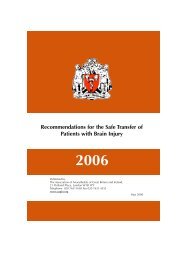TheatrePracticeStandardsGeneric1
Create successful ePaper yourself
Turn your PDF publications into a flip-book with our unique Google optimized e-Paper software.
6. Induction of anaesthesia<br />
• See Guidelines for the Anaesthetic Management of Patients with Latex Allergy<br />
7. Intraoperatively<br />
• The key is to avoid contact with latex on the skin, intravenously, by inhalation and<br />
particularly by contact with mucous membranes, peritoneum and serosal surfaces.<br />
• All staff must be aware of the need to maintain a latex free environment on the ward, in<br />
transit, in theatre and recovery. For type 1 hypersensitivity consider recovery in theatre.<br />
• The single most important precaution is to avoid any member of staff wearing latex<br />
containing gloves.<br />
8. Recovery<br />
• For patients with known type 1 hypersensitivity consider recovery in the operating<br />
theatre to mitigate the risk of exposure in other areas.<br />
• For all other patients there is no requirement to bypass the recovery area.<br />
9. What precautions should be taken with NRL-sensitive staff?<br />
• Staff who consider that they have a possible hypersensitivity should be refer to<br />
Occupational Health for screening.<br />
• All general staff equipment, gloves, masks etc used in the operating department are<br />
latex free, any replacement products considered must also be confirmed latex free<br />
before purchase.<br />
• Staff with known latex sensitivity must have regular review with their line manager and<br />
Occupational Health, documented in their personal file.<br />
70





